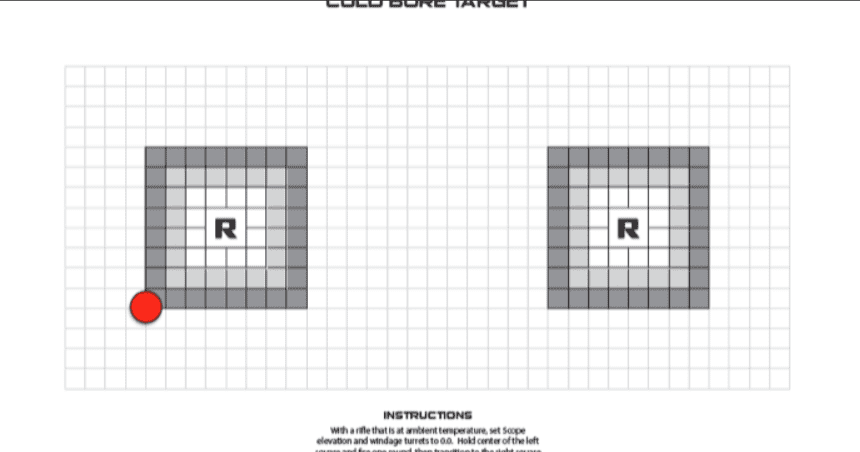
Recently I have found myself speaking with colleagues and lamenting about how precision shooters all too often mislabel various phenomenon’s surrounding precision rifles. Often this ignorance at best leads to a misuse of terms, but at its worse, it can lead to improper technique and loss of life in the professional realm. The “cold bore” phenomena are exactly such a hot button topic that instills much confusion thanks to the hundreds if not thousands of self-reported anecdotal opinions of amateur shooters.
Why get all worked up? Contrary to popular belief, being a professional Sniper simply means your paid occupation is to end bad guy behavior kinetically through the incorporation of precision shooting (among two dozen other tasks). The reality is that while some Snipers may become Subject Matter Experts given enough time to mature, the vast majority of professional Snipers, particularly in the Law Enforcement community, are operating with less than 5 years of experience and in some cases, certification training lasting all of about 40 hours.
Given those numbers the danger of young professional Snipers becoming inundated with false ideology about cold bore theory from amateur opinions posted in online forums, or the constant regurgitation of information from outdated manuals, is quite real. While the list of factors affecting shot placement during low percentage exposure engagements is long, for some reason cold bore shift remains a murky topic.
Continually we’ve seen or heard opinions on the matter of cold bore range along a spectrum from “cold bore is a myth”, to “I need to strip my bore down to metal after every time I shoot so I can duplicate my cold bore shot”. For the professional Sniper our first shot, especially during low percentage exposure engagements, is a high-risk event. Comprehension and mitigation of cold bore shift is a paramount task, there are no do overs, mulligans or alibis in our line of work.
Context and Terminology
So, where do we stand? Cold bore theory is a real thing! If you’re an operational professional sniper and you’re unaware of what cold bore is or how to document it, then someone has failed you. If that’s the case grab a notebook and standby as we come to terms with the concept of cold bore, in the context of the modern-day Sniper.
For starters defining terminology is indicative of concise communication, as is understanding of the core principles of the theories in question. Theories are narratives used help clarify the experience via known facts. Scientific knowledge is tentative and is by its nature subject to be superseded with new data. The following theories admittedly represent an overlap between both real-world experience and academic research and documentation. In general, they are brief yet distinct sets of knowledge, based off decades of professional peer-to-peer centric experience.
Cold Bore Shift – Is a consistent and repeatable deviation between a point of impact and the desired point of aim, that occurs when the rifle has been fired in a state in which the temperature of the bore and the ambient environmental temperature is the same. As the rifle (barrel, action, bolt, etc.) is heated upon the firing of the first round, there is a possibility that some rifles can have an uneven compression of materials. This then creates a slight change in the dimensional characteristics between those parts, as it is heated beyond ambient temperatures.
Clean Bore Shift – Is an inconsistent and therefor unrepeatable deviation between a point of impact and the desired point of aim, that occurs only after rifle has been cleaned and then fired. During the cleaning process carbon and copper deposits are often removed, essentially changing the inner dimensions of the bore. Also, inconsistent friction coefficients can appear due to residue left from cleaning agents.
Cold Shooter – Is an inconsistent and therefore unrepeatable deviation between a point of impact and the desired point of aim, that occurs due to the shooters inability to engage the rifle in a consistent physical manner. This can manifest itself in variety of ways, ranging from inconsistencies in the shooter’s head/eye placement, inconsistencies with trigger control, and inconsistencies with the shooters body position.
As one can see, anyone of the above phenomenon, or even combination thereof could be misidentified by the amateur as root cause for deviation in predicting shot solutions. The main key words regarding “cold bore” are consistent and repeatable. Conversely as stated, individual rifles or systems may present no significant deviations observable, leading a shooter to conclude that such phenomena are nothing more than hyped myths.
Mapping Shifts
Now if you’re a cold shooter, or that guy who thinks scrubbing his bore down to metal every 20 rounds is a great idea, then this mapping process isn’t going to help you. However, the tracking and recording of cold bore shifts is a relatively simple process and again, absolutely paramount considering the high-risk nature of shot placement during low percentage exposure engagements that snipers face.
(Note: The following examples are modeled off a typical professional sniper, firing duty grade .308 Winchester, zeroed at 100 yards, with a precision capability of 1 MOA.)
The Process
Step 1: With the a previously zeroed rifle and fouled bore (turrets set to “0/0”) that has been allowed to cool to ambient temperature, assume a good prone position and fire one round at the left target.

Step 2: Shifting your point of aim to the right target, fire 4 rounds to determine a mean point of impact.

Step 3: Using the reticle, measure the angular deviation for both vertical and horizontal shift (if any) from the mean point of impact of the last 4 rounds to the 1st round.

Step 4: Repeat the process in order to create a composite that denotes the average cold bore shift as to the average mean point of impacts from a warm bore. This averaged angular deviation can then be compensated for via dialing or holding in conjunction with ballistic solutions.
(The figure below demonstrates the composite of 3 different series of cold bore
maps overlaid but ideally at least 10 different series are recommended).
Cold Bore Correction: UP 1.5 MOA (0.4 MRAD) and RIGHT 1.0 MOA (0.3 MRAD)
Conclusions
The diagrams above showcase a “reasonable” theoretical cold bore shift. Again, while some rifles may never show a cold bore shift, some may be slightly less or more then the example shown. The point being that each individual rifle may be different, thus the need for the mapping.
Of particular note in the above example, we can see that failure to identify a rifle that demonstrates a cold bore tendency can become catastrophic in regarding shot placement during low percentage exposure engagements. Even with modeling set for the ideal circumstances, a rifle with an undocumented cold bore could potentially fail to deliver a round to certain anatomically correct targets. When we overlap the cold bore deviation with compounding issues, it can quickly become a cascading effect and become clear that the deck may not be stacking in favor of the ignorant.
(Note: The following examples are modeled off a typical professional sniper, firing duty grade .308 Winchester, zeroed at 100 yards, with a precision capability reduced to 2 MOA, due to such possibilities as command fire scenario, shooter fatigue/stress, or shots taken from alternate positions other than prone.)

Cold bore shift is indeed a real thing, not to be confused with a “Cold Shooter” or Clean Bore” phenomenon. Cold bore shift is a consistent and repeatable event. Cold bore shift is not prevalent in every rifle but failure to understand, identify and/or track a rifle with cold bore shift is negligence on the behalf of a professional sniper and a potential liability during sniper employment.



5 Responses
Great share! nice article . very impressive and useful post.
Please describe “duty grade”.308…
Examples would be Federal Gold Medal Match with Sierra Matchking 168’s or 175’s, Hornady TAP, or other similar Tactical bonded ammunition
Thanks Mate …
It’s what I have been having trouble with, It’s now up to me to amend the CBS with the rifle that I am currently using.
, I do all my cold bore notes in the temp of what I expect to hunt. Which is 30deg. average.